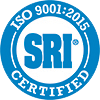Understanding the Difference Between Chromates and Passivates

Chromates and passivates are terms that we all see quite frequently in the various plating specifications. These terms are often used interchangeably; however, they technically differ. In this Plateco Pointer, we will take a deeper dive into the difference of a chromate versus a passivate coating.
To achieve the desired corrosion resistance outlined in a specification, it is possible to have 3 different deposit layers. The first layer is going to be the zinc coating. With the thickness of the zinc plating the second layer will be deposited: a post-treatment chromate or passivate that is necessary to provide an improved corrosion-resistant finish.
Chromate Verses Passivate
A chromate is a conversion coating in which hexavalent chrome reacts with a zinc finish to convert that finish into a protective coating. Passivates were developed in response to the drive to trivalent passivates.
Passivates may be divided into two categories: thin and thick film. The passivate film thickness ranges from 1 micron or more for thick film passivates to less than half a micron for thin film passivates. Thin film trivalent passivates are specified to provide a thin trivalent chrome coating over the plated zinc finish. Normally, the thin film passivates produce a bluer appearance than the thick film passivates. Thick film passivates are typically heated and contain a higher concentration of metal salts. Because of their thickness, these passivates generally provide more corrosion resistance.

